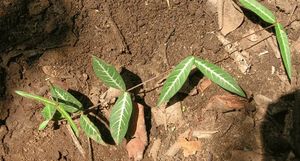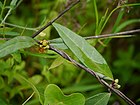Note: This is a project under development. The articles on this wiki are just being initiated and broadly incomplete. You can Help creating new pages.
Hemidesmus indicus - Ananthamoola
Hemidesmus indicus is a climber found throughout India.The plant is widely exploited from the wild for its root, which is used medicinally. Plant populations in some areas have dropped dramatically and the plant is now being experimentally cultivated in India.
Uses
Gums diseases in teeth, Hair fall, Dysuria, Eye diseases, Jaundice, Rheumatism, Arthritis, Body pain, Abdominal pain, Indigestion, Scabies, Eczema.
Parts Used
Chemical Composition
Nerolidol (1.2%), borneol (0.3%), linalyl acetate (0.2%), dihydrocarvyl acetate (0.1%), salicylaldehyde (0.1%), isocaryophyllene (0.1%), alpha terpinyl acetate (traces) and 1, 8-cineol (traces) are important as aromatic and bioactive principles[1]
Common names
| Language | Common name |
|---|---|
| Kannada | Sogadeberu |
| Hindi | Anantamul |
| Malayalam | Nannari Narunanti |
| Tamil | Nannari |
| Telugu | Nannari |
| Marathi | NA |
| Gujarathi | NA |
| Punjabi | NA |
| Kashmiri | NA |
| Sanskrit | Nagajihya |
| English | NA |
Properties
Reference: Dravya - Substance, Rasa - Taste, Guna - Qualities, VeNannarierya - Potency, Vipaka - Post-digesion effect, Karma - Pharmacological activity, Prabhava - Therepeutics.
Dravya
Rasa
Tikta (Bitter), Madhura (Sweet)
Guna
Guru (heavy), Snigda (oily)
Veerya
Sheeta (Cold)
Vipaka
Madhura (Sweet)
Karma
Kapha, Pitta
Prabhava
Habit
Identification
Leaf
| Kind | Shape | Feature |
|---|---|---|
| Simple | opposite | The leaves are variable, elliptic–oblong to linear–lanceolate, variegated, and white above and silvery-white pubescent beneath |
Flower
| Type | Size | Color and composition | Stamen | More information |
|---|---|---|---|---|
| Unisexual | 2-4cm long | greenish purple | 5-20 | Flowers are crowded in axillary cymes in small compact clusters |
Fruit
| Type | Size | Mass | Appearance | Seeds | More information |
|---|---|---|---|---|---|
| paired | Fruits cylindrical, pointed, and slender. Seeds are oblong in shape | fruits mature in January | many | {{{6}}} |
Other features
List of Ayurvedic medicine in which the herb is used
Where to get the saplings
Mode of Propagation
How to plant/cultivate
Land preparation and fertilizer application The field is ploughed and harrowed and levelled properly[4]
Commonly seen growing in areas
Photo Gallery
References
External Links
- Ayurvedic Herbs known to be helpful to treat Gums diseases in teeth
- Ayurvedic Herbs known to be helpful to treat Hair fall
- Ayurvedic Herbs known to be helpful to treat Dysuria
- Ayurvedic Herbs known to be helpful to treat Eye diseases
- Ayurvedic Herbs known to be helpful to treat Jaundice
- Ayurvedic Herbs known to be helpful to treat Rheumatism
- Ayurvedic Herbs known to be helpful to treat Arthritis
- Ayurvedic Herbs known to be helpful to treat Body pain
- Ayurvedic Herbs known to be helpful to treat Abdominal pain
- Ayurvedic Herbs known to be helpful to treat Indigestion
- Ayurvedic Herbs known to be helpful to treat Scabies
- Ayurvedic Herbs known to be helpful to treat Eczema
- Herbs with Roots used in medicine
- Herbs with Rhizome used in medicine
- Herbs with Leaves used in medicine
- Herbs with common name in Kannada
- Herbs with common name in Hindi
- Herbs with common name in Malayalam
- Herbs with common name in Tamil
- Herbs with common name in Telugu
- Herbs with common name in Sanskrit
- Habit - Twiner, Climber
- Index of Plants which can be propagated by Seeds
- Index of Plants which can be propagated by Cuttings
- Herbs that are commonly seen in the region of Tropical area
- Herbs that are commonly seen in the region of Subtropical area
- Herbs
- Ayurvedic herbs that don't have seed photos
- Apocynaceae







